My initial research into Samuel Katz, a son of my 3x-great-aunt Rahel Katzenstein, left me with several unanswered questions. Samuel and his wife Lorena and their son Jay had relocated from Kentucky to Omaha, Nebraska, in the 1880s.
One mystery involved Samuel’s occupation. Omaha directories listed more than one Samuel Katz for most of the years between 1885 and 1900, one of whom was a tailor living on 12th Street for some of the years while the other was first a grocer, then a clothing manufacturer, then a real estate agent, and then again a clothing manufacturer.[1] Then in the 1890s, Samuel Katz living at 2111 Douglas Street appeared to be in both the clothing business and the grading contracting business.
How had that evolved? I turned to my favorite research tool—old newspapers. Fortunately, newspapers.com has issues of the Omaha Bee from 1872 to 1916, and genealogybank.com has issues of the Omaha Daily Herald and the Omaha World-Herald ranging from 1878 through 1983 as well as as well as other Nebraska newspapers. I searched for “Katz” and was thrilled to find many relevant results from the search. Through those articles, I learned a great deal about my cousin Samuel Katz, the man, his family, and his businesses.
The earliest items I found that related to Samuel were many ads like this one for his grocery business:
I knew that had to be my Samuel Katz because the address matched what the 1885 Omaha directory listed as his business address:

Title : Omaha, Nebraska, City Directory, 1885 Source Information Ancestry.com. U.S. City Directories, 1822-1995 [database on-line]. Provo, UT, USA: Ancestry.com Operations, Inc., 2011. Original data: Original sources vary according to directory.
I will transcribe just the beginning of the article:
A short, dark-complexioned, black-haired and black-eyed young fellow named Alfred S. Hill was for some time employed by S. Katz as a driver of the delivery wagon. He was discharged recently, and on last Sunday night someone well acquainted with the premises entered the house where Mr Katz lives and stole a quantity of clothing, some money and two watches. Hill was arrested Tuesday evening on suspicion and locked up. He said he was not connected with the theft, but know who did the work.
“Will Tell for Money,” Omaha World-Herald, November 12, 1885, p. 4
[Hill identified another man, who was arrested. The story does not reveal what ultimately happened, and I did not find any follow-up. I was quite disturbed by the article’s physical description of Mr. Hill—why was that relevant?]
The fact that Mr. Hill drove a delivery truck for Samuel Katz seems consistent with the fact that Samuel was then in the grocery business.
But by July, 1886, Samuel was engaged in the grading business:
From thereon forward, there are numerous articles mentioning contracts he was awarded for doing road grading in the name of Katz & Callahan.
And beginning as early as 1887, there were also numerous ads like this one:
I knew this was also my Samuel Katz because it matched the Farnam Street address from the 1887 directory:

1887 Omaha directory
Ancestry.com. U.S. City Directories, 1822-1995 [database on-line]. Provo, UT, USA: Ancestry.com Operations, Inc., 2011.
So as early as that Samuel had diversified and was in three different lines of work: money lending, real estate, and grading. In addition, he was teaching in the Hebrew school:
When did he sleep? Money lender, real estate sales, grading contractor, and Hebrew school teacher!
Then in 1889, Samuel was in the clothing business, working for Polack Clothing Company:

1889 Omaha directory
Ancestry.com. U.S. City Directories, 1822-1995 [database on-line]. Provo, UT, USA: Ancestry.com Operations, Inc., 2011.
“Big Insurance Suit,” Daily Nebraska State Journal, September 17, 1889, p. 5:
“The store of the Polack Clothing company was destroyed by fire on May 31, 1889….”
Samuel then went into the clothing manufacturing business for some time with new partners, Charles Nevens and Lawrence Enewold, in September, 1889:
This news item describes their business, known as Katz-Nevens, as manufacturing “common and medium grades of clothing.”
But Samuel nevertheless also remained engaged in the grading business:
On top of that he was president of Temple Israel, his synagogue:
Once again I ask: When did he sleep?
I won’t bother to catalog all the articles from the 1890s describing Samuel’s activities both in the grading business and the clothing business as well as his synagogue activities, but suffice it to say that he continued to be active in all three endeavors throughout the decade. I did, however, find this article in which Samuel endorsed the re-election of the mayor of Omaha in 1893 very revealing:
I was impressed that Samuel could see beyond his own business interests and recognize that the mayor was acting in the best interests of the city even when turning down Samuel’s bids for grading contracts. That’s a sign of real integrity. (Or a cynic might say, a way of ingratiating himself in hopes of getting future contracts.)
And just to verify that this Samuel Katz was in fact the one who had moved from Kentucky, there is this news item:
Notice that Samuel was also a delegate to the I.O.B.B, the International Order of B’nai Brith. Another item to add to his already overloaded resume.
By the end of the decade, however, two things changed in Samuel’s life. First, Katz-Nevens, the clothing manufacturing business, was dissolved:
Then, Samuel retired as president of his congregation:
Thus, by 1900, when he responded to the enumerator’s question about his occupation, he was in fact only in the grading business.
But that would not stay the same for long. By 1905, Samuel was the treasurer of a new venture, Raapke & Katz Company, where his son Jay was also employed. What was Raapke & Katz? A grocery business—Samuel had come full circle:
One news item that has me quite intrigued is this small mention in April, 1905:
Who was the niece whose wedding Samuel attended back in Germany? I am now researching that question.
In 1906, although Jay is listed as a salesman for Raapke & Katz, Samuel only listed his grading business—Callahan Brothers & Katz— in the directory:

Omaha 1906 directory
Ancestry.com. U.S. City Directories, 1822-1995 [database on-line]. Provo, UT, USA: Ancestry.com Operations, Inc., 2011.
Original data: Original sources vary according to directory.
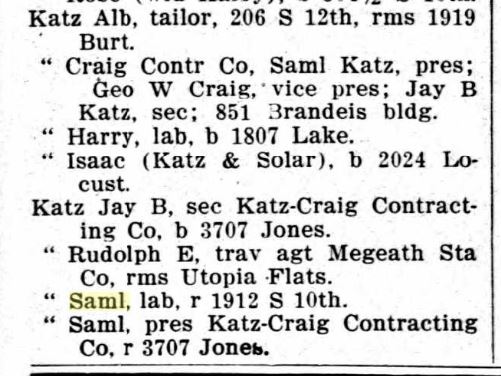
1909 Omaha directory Ancestry.com. U.S. City Directories, 1822-1995 [database on-line]. Provo, UT, USA: Ancestry.com Operations, Inc., 2011. Original data: Original sources vary according to directory.
On the 1910 census, Samuel and Jay are both described as in the stone contracting business, so that must have been the business of Katz, Craig Contracting:

Katz family on 1910 census
Year: 1910; Census Place: Omaha Ward 11, Douglas, Nebraska; Roll: T624_844; Page: 10B; Enumeration District: 0082; FHL microfilm: 1374857
But notice something strange about this census? It lists a second son of Samuel and Lorena: a 23 year old single man born in Kentucky named Sidney. You can imagine how that threw me for a loop when I first saw it. Where did HE come from?
Just another enumerator mistake, I concluded. Remember Samuel’s brother Abraham back in Kentucky with the ten children born in nineteen years? One of them was named Sidney and was the right age as the Sidney living with Samuel Katz in 1910. I believe that the Sidney listed on the 1910 census in Samuel’s household was his nephew, not his son.
In fact, the next year another of Abraham’s children came to live with Samuel Katz; Florence Katz came to study voice in Omaha. Lorena Rothschild Katz was herself a musician as was her sister Minnie, and so it probably seemed a good place for Florence to pursue her musical interests.
And remember Bertha Katz who was working as a stenographer for Katz-Nevens in 1899? Well, she also was likely the daughter of Samuel’s brother Abraham. Obviously, despite the long distance between the two brothers, they stayed in touch throughout the years. Samuel’s trip back to Germany in 1905 indicates that there also was a continuing connection to his family back in Jesberg.
Samuel Katz impressed me as quite a man: a man who was successful in several different businesses, a man who was committed to his faith and his people, and a man who was devoted to his family.
Sadly, his life was cut suddenly short on March 27, 1912, when he was only 59 years old.
Here is the text of his obituary. (How many errors can you find?)
Samuel Katz, aged 51 years and for thirty years a resident of Omaha, died shortly after 9 o’clock last night at his home, 3707 Jones street, of heart failure. Mr. Katz had not been well for a week or more, but last night was thought better. His death came suddenly and without the slightest warning, while he was preparing for a bath.
He is survived by his widow and one son, Jay B. Katz, of this city.
Samuel Katz was born in March 23, 1861, in Essen-Cassle [sic], Germany. At an early age he came to this country and located in Harroldsburg, K. After a short period in that place he moved to Omaha and became interested in the manufacturing of overalls and bought a controlling interest in the Katz-Nevins Manufacturing company. The latter was connected with the Raapke wholesale company at Fourteenth and Harney streets. About ten years ago he took up construction work and organized the Katz-Craig Construction company, he being at the head of this firm at the time of his death. Mr. Katz was regarded as one of the most able and exacting men in his line of work. Railroad and government construction work was his specialty and many of the finest buildings in this section of the country were built under his careful eye.
Samuel Katz was prominent in religious and charitable work, he being president of the Temple Israel at his death and also an officer in the local Jewish Associated Charities and the Independent order of B’Nai B’rith. He was a Mason.
The funeral of Mr. Katz will be held at 2 o’clock Friday afternoon at the residence on Jones street.
There was also a memorial service for Samuel Katz in May, 1912.
Perhaps all that energy devoted to family, faith, and work was just too much for Samuel.
More on his family in the next post.
[1] I ruled out the tailor since he had a son named Samuel, so I’ve assumed that my Samuel was in the clothing and real estate businesses.

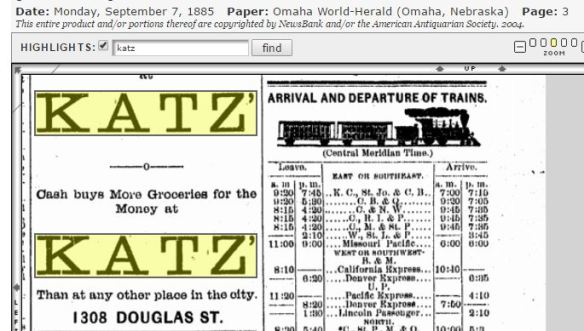



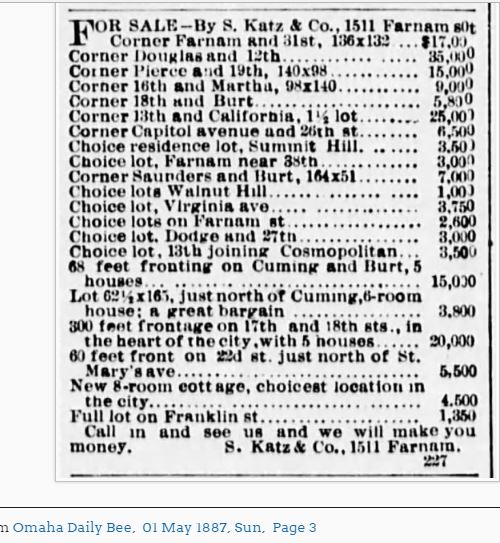
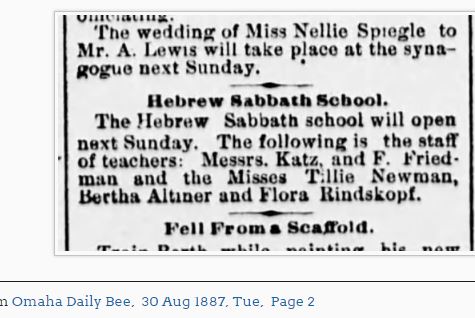






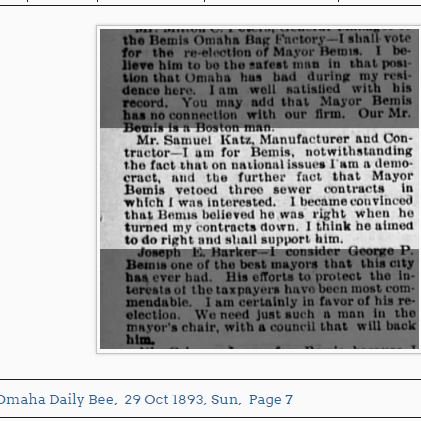
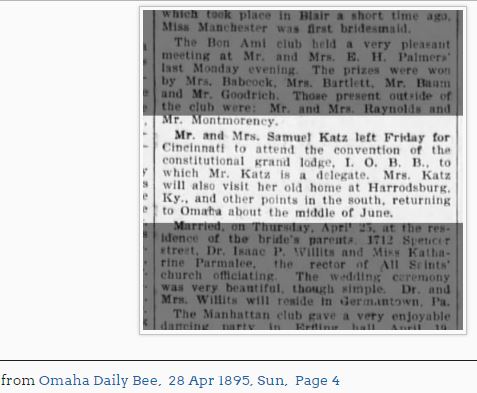

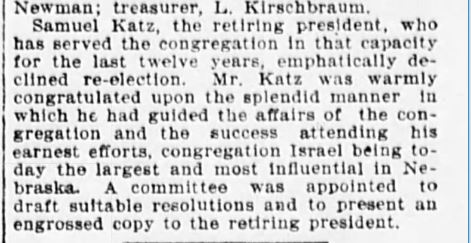




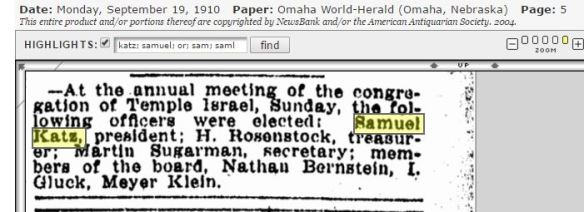



He was a busy man indeed, fascinating to be involved in such a variety of bussinesses!
I had to look up “grater”, never heard that before
LikeLike
Did you mean grader? Thanks for reading Lana!
LikeLike
Yes, grader! My comment disappeared after I posted it snd couldn’t figure out how to go edit it…
LikeLike
I assumed it was a typo, but then thought I might have missed one of his many jobs!!
LikeLike
It’s amazing how much of a person’s life can be pieced together from newspaper articles. How I wish Maine and New Jersey would get busy doing theirs. Great research once again.
LikeLike
Thanks, Linda! I’d also love to see more online—especially New Jersey. That state is a pain in many ways. Genealogically I mean!
LikeLike
What a busy man! He achieved so much in a relatively short life.
LikeLiked by 1 person
Yes, especially when you think about the fact that he came to the US as a young man, his accomplishments are remarkable.
LikeLiked by 1 person
I have such admiration for our immigrant ancestors.
LikeLiked by 1 person
When I think about what it meant to do that, it blows my mind that teenagers left home, came alone, and settled somewhere where the language and everything else was foreign. Can you imagine your son doing that? I can’t imagine my daughters doing that when they were young adults (or even now!).
LikeLiked by 1 person
It is pretty incredible. Most of my emigrant ancestors went to other English-speaking places, and went as families. I try to imagine my son alone in an alien place and it scares me. But I think that perhaps the sense that young people have of being bullet-proof is a great enabler.
LikeLiked by 1 person
Yes, probably true! Of course, as a parent, we know that sense is not realistic! So we worry more than they do.
LikeLiked by 1 person
Absolutely. I guess the trick is to find the balance between their confidence and our experience.
LikeLiked by 1 person
Wow! He was VERY busy. Hopefully he was a good delegator. What did/does a synagogue president do? I was also impressed by his integrity in supporting a mayor of a different party, who didn’t grant his bids. He seems like he was a wonderful person who gave so much of himself for others. He must have had lots of energy.
LikeLiked by 1 person
My husband was president of our synagogue for three years, and it is a big time commitment, at least now. You go to meetings, meet with the clergy, meet with congregants, etc. Not sure what he was back then.
Thanks for your thoughts! I am sure his direct descendants will appreciate your words.
LikeLiked by 1 person
Oh, that is busy. Lots of time serving others it sounds like. Good for your husband. 🙂
LikeLiked by 1 person
He did a great job—made some wonderful changes while he was president. And he enjoyed it—but it was time consuming!
LikeLiked by 1 person
AMY, Where do you live?
I am totally mesmerized reading all of this and oh, so wish that my late husband who was the name beneficiary of these men, Edwin JAY Baum, could read all of your research. He, in fact, was in the men’s clothing business (following his fathers’ footsteps who was originally a men’s clothing tailor, later a men’s clothing retail buyer). But Ed was also a talented entrepreneur and could build about anything. He owned and supported a number of different businesses and would have “fit right in” with the Omaha family (his mother’s family.) I wonder if you will find anything more about JAY KATZ, brother the Marian Katz Baum. I think the last that I knew of him was residing in Chicago….probably is no longer alive.
I’ll be interested in how much interest my adult kids and their cousins will maintain. I love that you “found us”!
Sue Schaefer Baum
LikeLiked by 2 people
Hi Sue—thanks so much for all this information! It does sound like Ed inherited his great-grandfather Samuel’s genes. I will try and give you a call tomorrow, if you’re around! THANKS!
LikeLike
It’s nice that his obituary provided confirmation to some things you’d learned. Again, old newspapers are great and I love that they tell us so many of the “mundane” things. But why oh why do they feel the need to charge us more for their “premium” papers?
LikeLiked by 1 person
Well, because those premium papers are still covered by copyright law and so they have to pay more to digitize them. It’s all about money! I am just glad to have access to them.
LikeLike
Hi Amy-this was an amazing post about an amazing man. Something jumped out at me, have I missed in the reading that you made the connection? Looking back at the census record with Sydney listed as son, did you notice the 2 names below him? Rothschild, sister in law and then mother in law? Neither is listed as head but under Samuels heading. It looks like the name is Annie and she is from Ky and look at the other women, same birth place as Samuel. 🙂
LikeLiked by 1 person
Hi Sharon–thanks for reading so carefully. Yes, Annie was Lorena’s sister and the other woman was her mother. I did know that, but since I’d already identified her background, I just didn’t mention it in the text in discussing the census.
LikeLiked by 1 person
of course, I should have known you wouldn’t have missed that 🙂 big big smile!
LikeLiked by 1 person
Oh, I miss plenty! So I appreciate all the help I can get. 🙂
LikeLiked by 1 person
Who is it who never sleeps? I’m betting the newspaper research kept you quite busy. I had a peek at the 1910 census a week or so ago. I wondered about a second son being listed but the hints for Sidney all pointed to Abraham. Great research, Amy.
LikeLiked by 1 person
LOL! Yes, I sometimes find that at 11:00 pm I make some breakthrough that keeps me going later than I intended! Thanks, Cathy!
LikeLiked by 1 person
Hi Amy. Did Sam and his wife ever settle with the fire insurers on all those claims? I’m sure that would be an entire series of postings and quite a story in itself.
About the mention of the thief having one leg, the mention of Williard’s disability was not considered unusual in the time period. I have seen official marriage licenses that ask questions using such words as moron, which at the time was acceptable to describe a person with slightly impaired mental faculties. It’s something we have to keep in mind when reading old newspapers: their use of language was not the same as today.
I have also seen questions on marriage licenses singling out epileptics, as if the condition makes one unfit for marriage. The mindset was so different as it is today. Today people with disabilities can live full lives thanks to the wide array of treatments, therapies and devices that assist them.
LikeLiked by 1 person
So far I’ve not seen any further report on that litigation. I am sure it settled out of court and was probably not reported. Insurance companies don’t like trials.
I was referring to the description of the man as dark-skinned, dark hair and dark eyes. Why make those references? I assume it was racist in intent. It’s not as if they were looking for a man identified that way by a witness—he had already been arrested and was talking to the police. It just seemed irrelevant and aimed at making a subtly racist observation.
LikeLiked by 1 person
I think you’re right.
LikeLiked by 1 person
I’m glad you brought this up. It’s a challenge reading period publications. Your research here provided a treasure trove. I think old newspapers and directories aren’t always considered the first go-to resource but they should be. From them we can at least get a location and if we know the area some idea of their economic level at the time.
LikeLiked by 1 person
I love the old newspapers. But I am always distracted by articles about other things and the advertisements!
LikeLiked by 1 person
Meet another delightfully distracted family historian. I sometimes think a posting on the ads would be fun. They can tell us about the times a person lived in–what the media tried to push as desireable.
One more thing about the old newspapers–when we have an address for our ancestor we can check the real estate ads and articles about the address and neighborhood. That also provides some indication of socio-economic status at a certain point.
LikeLiked by 1 person
Good point about the real estate ads—I’ve never done that. Thanks!
LikeLiked by 1 person
Wow – he was a real go-getter! I imagine he was always full of energy and needed to keep busy at all times. And that local newspaper is amazing – so much information, especially the tidbit about a niece’s marriage in 1905. I love those kinds of leads 🙂
LikeLiked by 1 person
As did I—and as you will see, I did find the answer!
LikeLike
Pingback: Abraham Katz Moves to Oklahoma | Brotmanblog: A Family Journey
Great job researching Samuel Katz. I agree that newspapers are a great way to learn more about our ancestors. Amazing to see an actual picture of Samuel as well!
LikeLiked by 1 person
Thank you! I know—there is nothing like seeing the faces that go with the names, is there?
LikeLiked by 1 person
Great research! I have several receipts from the Katz-Nevens Company from the 1890’s and didn’t know their history until now.
LikeLiked by 1 person
Thank you! I will email you as I’d love to see the receipts!
LikeLike